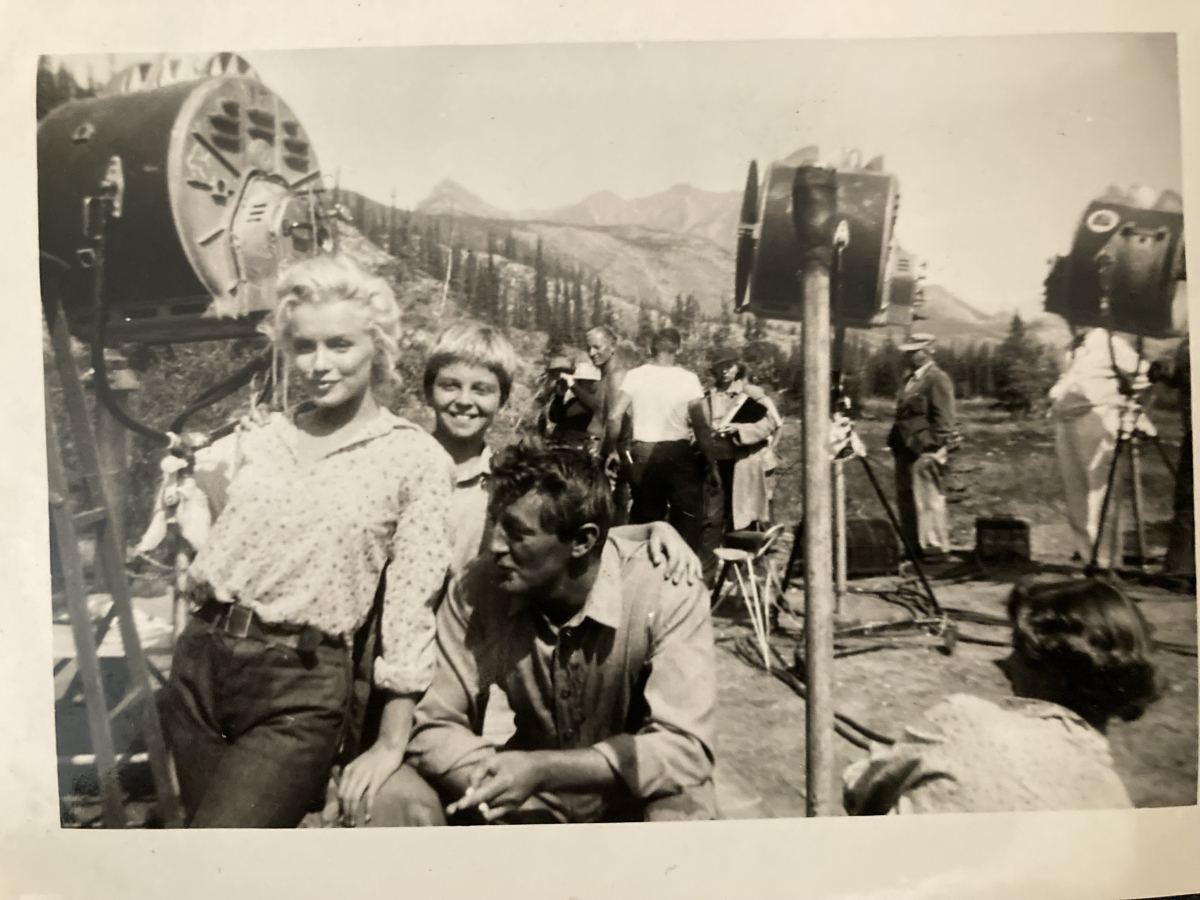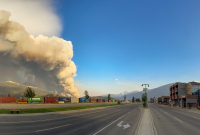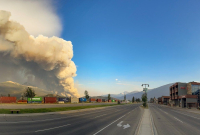Jasper's fire has turned personal history into ash

The photos of the devastating fire in the townsite of Jasper are a gut punch. That’s the shocking present — the homes ablaze, the Anglican church with its blackened steeple reaching into the smoke-filled sky — and it’s unbearable.
But right now, it’s images of the past that are responsible for the tightness in my throat, the sick feeling in my stomach, and the tears. Those past images are captured in the black-and-white photos from my childhood, when I visited the Jasper Park Lodge over many summers to stay with family, who worked as staff at the grand railway hotel, and who actually lived within that fabled landscape.
We called them Auntie Pat and Uncle Bill, though my aunt was actually my dad’s first cousin, closely connected to him and to us within a large, loving and tight-knit Faulder family that has deep roots in Jasper. Uncle Bill was the head groundskeeper at the JPL for decades when it was owned by the Canadian National Railway, and later, Canadian Pacific Hotels. The family lived in what is today known as the Gardener’s Cabin. Now, it’s a posh retreat for guests, if it’s even still standing by the time this column is published. Media reports say flames have reached the grounds, but there is no conclusive information as to the Lodge’s condition at the time of this writing.
Back then, the cabin was rustic, and a cramped space for a family of five. As head groundskeeper, my uncle was responsible for the carpet of green grass surrounding the Lodge and for the countless bright red geraniums and other hardy northern annuals and shrubs that tamed the wild beauty of the resort.
Even today, I can’t smell dirt without remembering the feeling of being in the greenhouse, the dark, damp scent of it, the squeak and slam of the screen door that separated the family’s living quarters from the glass-enclosed rows upon rows of sprouting seedlings. It was located near the massive laundry facility of the resort and often the hot smell of clean sheets drying wafted past the gardener’s cabin. Summer and winter, my family drove to the Lodge to visit, to enjoy the national park, and to ski.
Auntie Pat and Uncle Bill had three youngsters, and one of them, Barbie, was exactly my age. She and I roamed free throughout the grounds, playing our imaginary games along the shores of Lac Beauvert. We weren’t allowed in the main building, but we could use the pool, which at that time was located within skittering distance of the turquoise lake. We would alternate between swimming in the pool, and immediately running down to the pier. Then we would dive into the lake itself, thrilling at the skin-tingling contrast between the heated pool and the glacial chill of the water.
The summer I turned 18, my uncle got me a summer job working at a gift shop in the town of Jasper, where I got to know the beer parlour at the landmark Atha-B quite well. My mother before me had also worked in Jasper as a teenager, cleaning hotel rooms in the 1950s. Her black-and-white photos include snaps of Marilyn Monroe and Robert Mitchum, who were filming The River of No Return the summer she was a chambermaid.

These are my memories of the town of Jasper, and of the Lodge, and there are so many more extending to my last trip there a couple of years ago, and the many weeks I spent at the annual food and wine event, Christmas in November, during my tenure as a food writer for the Edmonton Journal. But even as I reach for those memories, hoping, hoping, to build on them again, the present returns.
I talk to my cousin on the phone. She lives in the Edmonton area now, but her son, an expert kayaker who works as a guide in Jasper, has been evacuated. Picking up his 92-year-old grandmother, my Auntie Pat, from her senior’s lodge in the town of Jasper, he is now in the B.C. village of Valemount. The two are trying to make their way to the Edmonton area while skirting highway closures, Auntie Pat’s precious sewing machine in tow.
Just a couple of days earlier, he had been on a Jasper river, in a boat with his girlfriend when it became clear the fire was a dangerous threat. They had parked their two cars at planned in and out points on the river; his car was incinerated, but hers was still there. They managed to escape harm.
I’m not going to pretend my feelings about the devastation in Jasper are a patch on what the evacuated townspeople and those who live in the surrounding communities are feeling. I’m not smelling the smoke, feeling the soot, watching online reports for news about my home.
But like so many Albertans, and others across the country, my past is tied to this park, this town and its historic mountain resort. To see, via Facebook, the town’s landmarks disappearing, and imagine the flames licking at the Jasper Park Lodge lobby itself is like seeing my past crumble into ash. I want desperately to speak to my mom and dad about the fire, about our family. But they both died in 2023.
I know what my dad would say, though, if he was here. I would be crying. He would listen, give me a hug. Then he would remind me that, in 1952, the main lodge building was destroyed by fire, only to be rebuilt in 1953. He would not say I shouldn’t worry, that it will all be okay. He wasn’t a Pollyanna kind of guy. But we would be together in hope.





Comments
In addition to sadness, there should be a feeling of anger at what has happened to the town of Jasper and Jasper National Park. Climate change, brought on primarily by burning of fossil fuels is the root cause of the devastating fires that consumed Jasper, Lytton, BC and Fort McMurray. In spite of this, Danielle Smith and her big oil CEO cronies are hell bent on INCREASING oil and gas production to maximize profit before the rest of the world (exceptions being Canada, Russia and a few other countries) shifts to renewable energy. Every Canadian, but especially Albertans, should sit down and read John Vaillant's Fire Weather:The Making of a Beast and David Wallace-Wells' The Uninhabitable Earth. This is our future unless we move quickly to leave oil in the ground and rapidly develop renewable energy sources.
Alberta has been happily pouring oil into the atmospheric climate for years. It is sad that fire took its revenge on the province most cherished treasure.
Alberta's Premier happily continues to shill for oil, eschewing climate solutions. Her crocodile tears about Jasper all over the media are sickening. Not once did she link the devastation to climate change and her unending reckless pursuit of fossil fuels. I guess it's to be expected from an oil lobbyist, but why is no media calling her on her crap?
I wished someone in the careful questions had said to her, "Yeah, we know how you feel; it's ALSO how most of us feel about climate change, you science-denying idiot."
When Fort McMurray was devastated by a massive forest conflagration, the suddenness and scale of the damage garnered international attention. Many donation websites were set up, and charitable organizations activated a good number of them. Donation boxes appeared in many Vancouver department stores and even BC liquor stores to help rebuild the town. At that point the sympathy for 80,000 residents outweighed the tendency in some quarters to blame them for working in one of the world's most notorious instruments of climate change.
Not long after the Fort Mac fire BC took the federal government to court to try to stop the Trans Mountain Pipeline project from putting so many of BC's pristine landscapes, marine ecosystems and communities at risk of toxic spills, and for overriding the rights of municipalities in the pipe's path. The pro-oil media, corporations and citizens reacted with predictable narratives. But the worst came from more than one Fort Mac resident whose letters were published in the Vancouver Sun, and National Post and other media. The local Fort Mac paper published a damning editorial with a similar slant about extremists, radicals, ecoterrorists and what have you. Some commenters called for shutting off BC's oil and gas supplies, not realizing that most of the gas originates in BC itself.
I was angry enough to send a letter to the editor of the Fort Mac paper demanding my donation money back along with the hundreds of thousands of dollars willingly given by BC residents. Nothing came of it, of course.
And today it's the beautiful town of Jasper situated in one of the world's most beautiful national parks, now on fire. It will be rebuilt, the donations will flow and the forest will regrow. But the lesson Alberta's residents and leadership will be forced to learn once again is that they will be dealing with the consequences of carbon pollution for a long time. But now the economic forces against fossil fuel dependency is mounting in Alberta's export markets and will continue as such until the carbon in Alberta's economy is brought down dramatically by the energy from wind, solar and the heat from deep within the Earth.
Weep for Jasper. It is a profound loss. Then sober up and have a good think about a future without fossil fuels in the dominant position.
Loved this article. Thanks for it.
"my uncle was responsible for the carpet of green grass surrounding the Lodge and for the countless bright red geraniums and other hardy northern annuals and shrubs that tamed the wild beauty of the resort."
Is that what we are mourning - the heritage of colonial exploitation that 'tamed the wild beauty of Jasper National Park? The European alpine tourists that named all the peaks? The scars made by CN Rail, including the hotels?
Yes, this is not a sympathetic comment, and given the number of times I've driven to Jasper to hike, climb and ski over the last 40 years, pretty selfish - but rationally, any plan to "rebuild Jasper" must look hard at the role of the township in Jasper National Park.
Is it to be the minimum intrusion necessary to support Park Operations in support of the ecosystem, or is it to be a tourist destination for tens of thousands of people to fly and drive there until the CO2 level kills off the ecology?